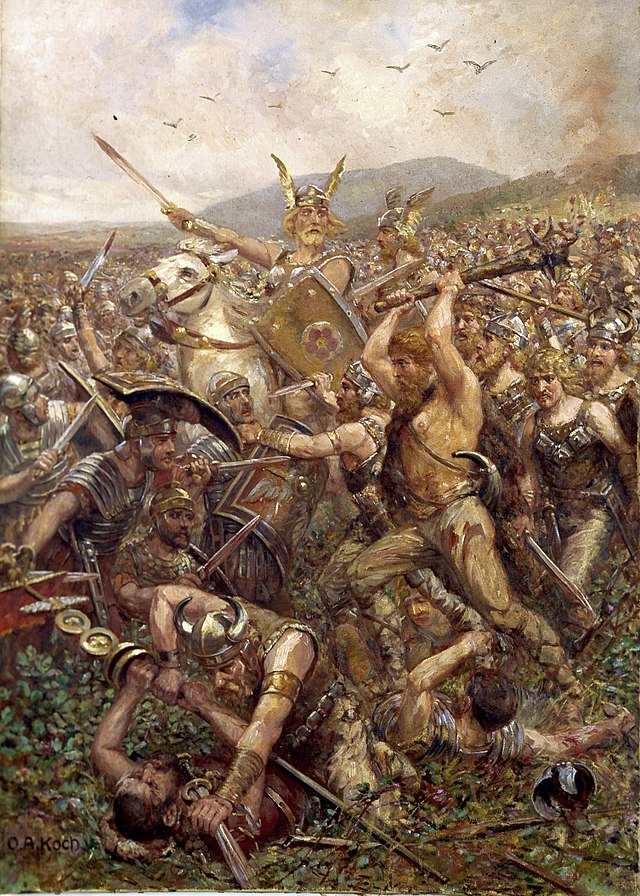Part 5 of 5
Mike Scruggs
On the morning of September 11, Lucius Eggius led the first of two 4,000-man battle groups out of the Roman camp to the northwest. He would soon be followed by the second battle group commanded by Caeonius. The circumstances demanded that their seriously wounded comrades be left to their fate within the camp palisade.
In a short while, it became obvious to Eggius that their only plausible escape route was a narrow passage between Kalkriese Hill on their left and impassable marshes on the right, with less than 100 yards between the two. Further narrowing the passage, the Germans had constructed 500 yards of earthen ramparts, 15 feet wide and 5 feet high, on the lower slopes of Kalkriese Hill. The ramparts were topped with a palisade of posts and twisted tree limbs giving the German defenders protection up to chest level. These ramparts had many hidden gates camouflaged with brushwood. From these gates, the Germans could launch surprise cavalry and infantry attacks, throwing the Romans into confusion. The German chieftain Arminius had obviously been an attentive student of Roman warfare and defense works.
Eggius quickly realized that marching his troops past a bottleneck hail of German lances, spears, rocks, and arrows with limited ability to engage the enemy on favorable terms was going to be both deadly and futile. Eggius thus concentrated as many of his troops as possible and ordered an assault on a section of the rampart. Holding their shields above their heads in a “tortoise assault” formation, the Romans bravely engaged the Germans standing above them on palisaded ramparts.
About this time, Caeonius and the second Roman battle group, left the safety of the Roman camp and began to catch up with Eggius. When their rear guard was several hundred yards from the camp, they were suddenly assaulted by a formidable Bructeri infantry force surging from the forest on their left flank. No sooner had they positioned to defend against this furious, howling charge on their left, than a larger cavalry and infantry force assaulted their right flank, probably led by Arminius himself.
Many of the German cavalrymen were wearing Roman equipment. The second Roman battle group was quickly broken up and routed. Most were slaughtered in the confusing melee, but many fled into the rear of Eggius’s battle group, causing them confusion. A few hundred, including Caeonius, were able to make it back to the safety of the palisade protected Roman camp.
Meanwhile, the Roman “tortoise assault,” keeping their shields over their heads to produce a huge protective roof of shields that denied the Germans complete tactical domination because of the height of the ramparts and palisades, was having at least some success. Their shield-roof could also be used as a shield-ramp to place men and tools in a position to destroy or breach palisade defenses. Several places on the ramparts and palisades had collapsed or were temporarily breached. When reports came forward that the second battle group had been almost totally destroyed, Eggius probably realized that Arminius would soon be in a position to attack his rear or block his retreat.
Moreover, the Germans then released cavalry and infantry assaults from the camouflaged gates of their ramparts, soon resulting in Roman confusion and disorder. Eggius was killed, and the courageous Roman “tortoise assault’ on the ramparts faltered and then failed. The Germans continued to use surprise attacks from hidden rampart gates to break up Roman units and destroy them in detail. In the end, pure numbers and Germanic fury overwhelmed the desperate and outmaneuvered Romans, who fought bravely to the last man. Only a small Roman cavalry vanguard was able to slip past the berserk fury of the last group Agrivarii warriors.
Having completed the destruction of the last Roman resistance beneath Kalkriese Hill, Arminius and an intimidating force arrived at the gate of the Roman camp, now called Felsenfeld. He sent a small group forward to offer safe conduct for Caeonius to speak with him. Arminius had only one question. “Where is Varus?” Caeonius led him into the camp and showed him a grave, where the partially burned body of Varus was buried. At Arminius’s signal, the Germans secured the gate, overran the camp, and killed Caeonius and his remaining soldiers. The Germans dragged Varus’s half-burned body out of the shallow grave and severed his head. Varus’s head was carefully packed and sent to Maroboduus, Arminius’s chief Germanic rival and leader of the formidable Marcomanni tribal coalition. Maroboduus refused to be intimidated and sent the carefully packed head to Rome.
A number of other tribes joined Arminius in his rebellion against Rome, but in 14 AD Tiberius became emperor, succeeding Augustus. In 15 AD, Tiberius sent the young Roman General Germanicus to Germania to settle some scores, punishing the Cherusci, the Bructeri, the Marsi, and the Angrivarii for their support of Arminius. Germanicus’s legions also found the skeletons of many Roman soldiers in Teutoburg Forest.
His soldiers interred their remains with great care in several burial mounds, giving great honor and respect to their former comrades in arms. Germanicus was able to recover two of the three sacred Legion Eagles, symbolically equivalent to battle flags. The third was recovered in 41 AD. Germanicus defeated Arminius in several battles, but was never able to overcome him. In 16 AD, he captured Arminius’s pregnant 26-year-old wife, Thusnelda, and took her to Rome as a hostage. She was treated well there, but Arminius never saw her again. Arminius was murdered in 21 AD (age 40) by political rivals claiming he was growing too powerful. His only son, Thumelicus, whom he never saw, became a Roman gladiator and died young.
Probably, at least 4,000 men of Varus’s legions survived Teutoburg. That would include approximately 3,000 German auxiliaries and other legion soldiers whose cultural and family loyalties could not be bought with Roman money or Roman citizenship, especially in light of Varus’s terrible misunderstanding of and disregard for Germanic culture. Perhaps another thousand who went ahead with 19th Legion Prefect Lucius Caedicius to Aliso survived. The Germans also enslaved some military prisoners.
After 16 AD, the Romans never again tried to occupy Germanic territory east of the Rhine. Tiberius did not consider ruling Germany worth the cost in Roman wealth and Roman soldiers.
Although clearly superior in military power, the Romans had become thoroughly intimidated by the Germanic reputation for terrible and unrelenting fury gained by their near complete annihilation of three Roman legions at Teutoburg.





